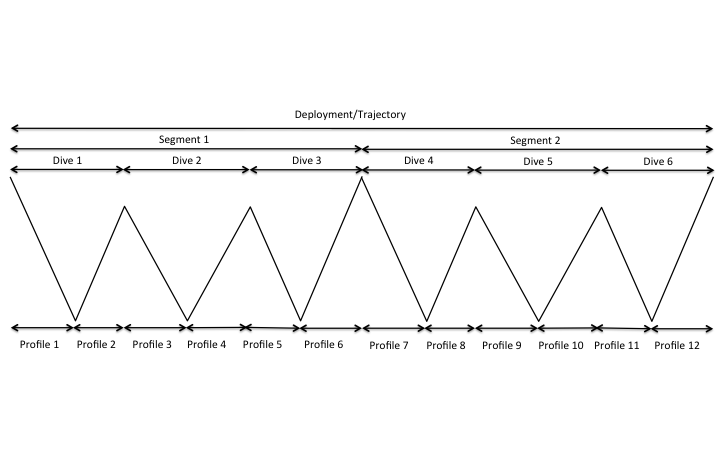This page defines glider and sampling terminology used throughout the rest of the Wiki.
Edit me
Glider Types
As of this writing, there are 3 major buoyancy driven glider types that are currently utilized by IOOS Regional Associations:
- Seaglider: originally designed and built through a collaboration with the University of Washington’s Applied Physics Lab and School of Oceanography.
- Spray: originally designed by Scripps Institution of Oceanography and Woods Hole Oceanographic Institution with funding provided by the Office of Naval Research, the Spray glider is now manufactured by Bluefin Robotics.
- Slocum: designed and built by Teledyne Webb Research Corporation.
Sampling Pattern Terminology
The schematic and definitions below define the sampling terminology of a profiling glider. While all of the terms defined below are commonly used in the glider community, the 2 fundamental terms used by the NGDAC to organize data are the profile and trajectory. The NGDAC receives glider data as individual, sequentially numbered profiles and aggregates files from the same trajectory into a single data set representing the deployment.

- Profile: A single vertically oriented track of a glider, either upward or downward through the water column. A profile is one-half of a dive. The profile is the fundamental atomic data type used by the NGDAC. All data submitted to the NGDAC is submitted as individual profiles, containing the various water column properties or sensor values. Examples of the file format description can be found as CDL, NetCDF file and ncml can be found here.
- Dive: A single vertical profile to depth followed by a vertical profile towards the surface. A dive does not necessarily begin with or terminate with a surfacing and/or gps fix.
- Segment: The set of data collected between 2 gps fixes obtained while the glider is on the surface of the water. The first gps fix is acquired prior to the beginning of a dive and the second gps fix is acquired following the completion of at least one dive. Glider segments always consist of at least one, and possibly many dives.
- Trajectory or Deployment: A series of one or more segments completed by a glider between the time of deployment and the time of recovery.
A detailed description of the official NetCDF file format used by the NGDAC can be found here.